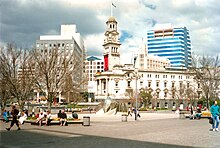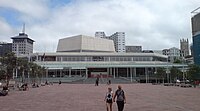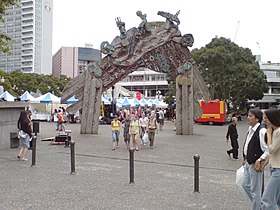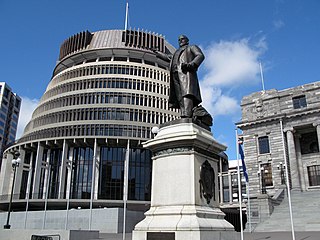
Wellington is the capital city of New Zealand. It is located at the south-western tip of the North Island, between Cook Strait and the Remutaka Range. Wellington is the third-largest city in New Zealand, and is the administrative centre of the Wellington Region. It is the world's southernmost capital of a sovereign state. Wellington features a temperate maritime climate, and is the world's windiest city by average wind speed.

Great Barrier Island lies in the outer Hauraki Gulf, New Zealand, 100 kilometres (62 mi) north-east of central Auckland. With an area of 285 square kilometres (110 sq mi) it is the sixth-largest island of New Zealand and fourth-largest in the main chain. Its highest point, Mount Hobson, is 627 metres (2,057 ft) above sea level. The local authority is the Auckland Council.

Queen Street is the major commercial thoroughfare in the Auckland City Centre, Auckland, New Zealand's main population centre. The northern end is at Queens Wharf on the Auckland waterfront, adjacent to the Britomart Transport Centre and the Downtown Ferry Terminal. The road is close to straight, the southern end being almost three kilometres away in a south-southwesterly direction on the Karangahape Road ridge, close to the residential suburbs in the interior of the Auckland isthmus.

Freemans Bay is the name of a former bay and now inner city suburb of Auckland, in the North Island of New Zealand. The bay has been filled in to a considerable extent, with the reclamation area now totally concealing the ancient shoreline. Historically a poor and often disreputable quarter, it is now a comparatively wealthy and desirable neighbourhood known for its mix of heritage homes and more recent single-dwelling houses, as well as for its two large parks.

Waitematā railway station, commonly known as Britomart railway station or Britomart Transport Centre, is the public transport hub in the central business district of Auckland and the northern terminus of the North Island Main Trunk railway line. It combines a railway station in a former Edwardian post office, extended with expansive modernist architectural elements, with a bus interchange. It is at the foot of Queen Street, the main commercial thoroughfare of the CBD, with the main ferry terminal just across Quay Street.

Holy Trinity Cathedral is an Anglican cathedral church situated in Parnell, a residential suburb of Auckland, New Zealand. It is the 'mother church' of the Anglican Diocese of Auckland and the seat of the Bishop of Auckland. The current main church building was consecrated in 1973.
Shona Rapira Davies is a sculptor and painter of Ngātiwai ki Aotea tribal descent. Currently residing in Wellington New Zealand.
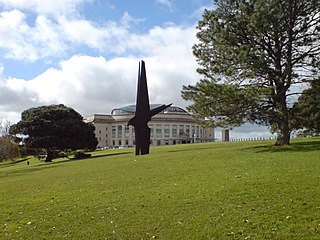
The Auckland Domain, also known as Pukekawa / Auckland Domain, is a large park in Auckland, New Zealand. Consisting of 75 hectares of land, Auckland Domain is the oldest park in the city. Located in the central suburb of Grafton, the parkland is the remains of the explosion crater and most of the surrounding tuff ring of the Pukekawa volcano.

Waihorotiu, sometimes called the Waihorotiu Stream and the 'Queen Street River', is a stream that ran down the Queen Street gully in the Auckland CBD, New Zealand, into the Waitemata Harbour. It has long since been covered over and put underground by the urbanisation of the area.

Paratene Temokopuorongo Matchitt was a New Zealand sculptor and painter, known for combining traditional Māori art forms with those of modernist art. His work also references events from New Zealand history, particularly the Māori prophetic movements of the nineteenth century and most specifically Te Kooti.

The NDG Auckland Centre is a proposed tower block consisting of a Ritz-Carlton hotel skyscraper in Auckland, New Zealand. If the tower is built, it would become the second tallest building in New Zealand at 209 metres (686 ft) and the second-tallest freestanding structure in Auckland after the Sky Tower.

The Auckland Central Business District (CBD), or Auckland city centre, is the geographical and economic heart of the Auckland metropolitan area. It is the area in which Auckland was established in 1840, by William Hobson on land gifted by mana whenuahapū Ngāti Whātua Ōrākei. It is New Zealand's leading financial hub, and the centre of the country's economy; the GDP of the Auckland Region was NZD$139 billion in the year ending September 2023.

The Aotea Centre is a performing arts and events centre in Auckland, New Zealand. Located at the western edge of Aotea Square, off Queen Street, the centre provides a cultural, entertainment and conventions venue space in the heart of the city, and is managed by Auckland Unlimited. The origin of its name is Motu Aotea, the Māori name for Great Barrier Island, which is the largest offshore island of New Zealand and approximately 90 km from downtown Auckland.
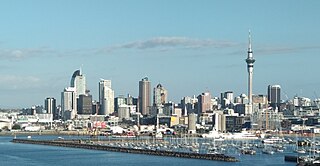
Auckland is a large metropolitan city in the North Island of New Zealand. It has an urban population of about 1,478,800. It is located in the greater Auckland Region, the area governed by Auckland Council, which includes outlying rural areas and the islands of the Hauraki Gulf, and which has a total population of 1,739,300 as of June 2023. It is the most populous city of New Zealand and the fifth largest city in Oceania. While Europeans continue to make up the plurality of Auckland's population, the city became multicultural and cosmopolitan in the late-20th century, with Asians accounting for 31% of the city's population in 2018. Auckland has the fourth largest foreign-born population in the world, with 39% of its residents born overseas. With its large population of Pasifika New Zealanders, the city is also home to the biggest ethnic Polynesian population in the world. The Māori-language name for Auckland is Tāmaki Makaurau, meaning "Tāmaki desired by many", in reference to the desirability of its natural resources and geography.

The City Rail Link (CRL) is a rail project currently under construction in Auckland, New Zealand. The project consists of a 3.5 km (2.2 mi) long double-track rail tunnel underneath Auckland's city centre, between Waitematā (Britomart) and Maungawhau railway stations. Two new underground stations will be constructed to serve the city centre: Te Waihorotiu near Aotea Square and Karanga-a-Hape near Karangahape Road. Waitematā will be converted from a terminus station into a through station, and Mount Eden station will be replaced by Maungawhau station, a new station with four platforms to serve as an interchange between the new CRL line and the existing Western Line.

Occupy Movement protests took place in New Zealand, beginning on 15 October 2011 with the Occupation of Auckland. Occupy protests took place in Auckland, New Plymouth, Wellington, Lower Hutt, Christchurch, Dunedin, and Invercargill.
There have been several COVID-19 protests in New Zealand held since 2020, where people protested the government's response to the COVID-19 pandemic in New Zealand, in particular the lockdown measures in place in March–May 2020, August 2020, and August–November 2021 and the later vaccine mandates. Most politicians both within and outside of Government and the vast majority of people have condemned these protests and view them as grandstanding by the organisers, and fear they may have spread the virus.

The Albert Park Volcano was one of the volcanoes in the Auckland volcanic field in New Zealand. A small volcano that erupted approximately 145,000 years ago, the volcanic remnants were quarried during the early colonial history of Auckland between 1840 and 1869. The volcano was dwarfed by the pre-volcanic sandstone ridge of Albert Park directly to the south-east, and only recognised as volcanic by Ferdinand von Hochstetter when he visited Auckland in 1859.

Mountain Fountain is a public sculpture located in the Parnell suburb of Auckland, New Zealand. It was designed by Terry Stringer and depicts a bronze Cubist volcano thrusting up from a concrete base, with streams of water falling from three of the sculpture's four faces. It was erected in its original location in Aotea Square in 1981. In 2008, it was decommissioned and placed in storage during redevelopment of the square. It was relocated to its current site in the forecourt of Holy Trinity Cathedral in 2010.

Waharoa, also known as Te Waharoa o Aotea, is a public sculpture located in Aotea Square, the city centre of Auckland, New Zealand. The expressionist piece was designed by Selwyn Muru and depicts a waharoa, a traditional Māori gateway in front of a marae ātea; the open meeting courtyard at a marae. Muru took elements from traditional Māori and Pacific art forms, as well as contemporary elements. The work was erected at Aotea Square in 1990 and relocated to its current position in 2010. Artist Mei Hill has described Waharoa as "probably the defining Māori artwork of scale in Auckland".

